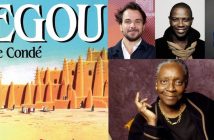Two opening images establish a position that the film maintains throughout, and we know right from the start that this is a just vision. Two truly moving images. The first is of a man and a woman on a bike. They know that they are being filmed, and look smilingly into the camera. The second shows people walking along a road. They too are aware that they are being filmed, the camera framing them in a low-angle shot, almost down at ground level, magnifying them as humans.
Right from the outset, in the space of these two images, this film is magnificent. These two image-manifestos show that this film is an exchange with the people shown, who are filmed quite openly, not without them realising. It is a gaze that refuses to melt them into the crowd – that of the dead. They also show that this film intends to speak about life, not death, or rather about how much death open us up to life. This film is an ode to life, and thus an indictment against those who use death to manipulate the living.
This is only ever suggested, however, not openly denounced. Yet this film focuses on writers who have the words, but who are still under the shock, and who ask themselves questions, free of all preconceptions. Dotted with interviews with Boubacar Boris Diop, Véronique Tadjo, Benjamin Sehene, Nocky Djedanoum, Koulsy Lamko and Yves Simon, who all took part in the writing residence organised by the Lille literary festival, Fest’Africa, in Rwanda in May 2000, Rwanda pour mémoire testifies to these ten writers’ undertaking to break the African intellectuals’ silence over the 1994 genocide.
1994 was the year Mandela was released from prison and the end of apartheid. It was also the year the World Cup was held in the United States. Why on earth should the world have wanted to let the Rwandan tragedy spoil the party? And what can we understand from this? « You fall into the trap because you want to find out what difference led to the genocide when there is no difference », says the Rwandan Benjamin Sehene. The writers speak into a microphone, which can be seen in the frame. The aim here is to liberate speech, for words to grasp the genocide. For a ritual is necessary if a grieving process is to be possible, a ritual of writing « to contribute to the world’s memory », as the French writer Yves Simon says.
It is indeed a question of memory. « There is a dormant beast in each and every man and woman », reminds the Ivoirian Véronique Tadjo. Memory is about understanding that this is man’s nature. So what’s the point of continuing to exhibit the corpses? Someone answers: to stop the revisionists from performing their macabre inversions. The genocide happened. It has to be shown to avoid repetition. And the families are forbidden from burying their kin, on the excuse that, as instruments of memory, they no longer belong to them.
Yet, the Chadian Koulsy Lamko reminds, « you have to bury the dead, otherwise the geometrids (moths) will continue to torment the living ». Should one film the dead? Samba Félix Ndiaye cannot bring himself to take part in the macabre exhibition of bodies, the men, women and children still rigid with terror. Like Djibril Diop Mambety in « Touki Bouki« , he prefers the slaughterhouse. The blood flows profusely, running down into and mingling with the river’s waters. The cow dies in close-up. The human corpses are kept at a distance – that of a half-open door, of the distraught faces of the visitors at Murambi, the site where 40 to 60 000 people were massacred. There were only 20 survivors. The emotion is present, but is not sentimental. It is the conscience of what happened and it is in this respect that it is memory. « There is no explanation as to why a woman kills her children », says Benjamin Sehene. « Rwanda was gripped by madness ». Because they need to, the survivors recount, show their battered skulls, their amputated arms. Along with the dead, it is the heritage of entire clans that have been buried, a history erased forever. But the film does not dwell on all of this. People walk along the road, for life goes on.
François, a survivor and guardian of Murambi, shows his brother. He has his wooden coffin, unlike the rest. Yves Simon denounces « the macabre, violent and cynical representation » that this exhibition of the dead constitutes. Koulsy Lamko speaks of a « voyeuristic gaze that feels like a kind of profanation ». And the filmmaker Samba Félix Ndiaye questions the image, the ostentatious showing of the dead, discussing it with the writers. To show is to manipulate, to arouse a guilty conscience, to cut short reflecting on the human, the only one apt to rediscover his markers, to counter the discourses of hate and intolerance that constitute him.
Genocide does not kill hope; it questions the very depths of the human, this beast present in each and every one of us. « The cinema produces memories », Godard once said. This indispensable memory does not consist of setting out the crimes, but of thinking about them. Samba Félix Ndiaye’s camera seeks the right distance. « One of the lessons of genocide is that you can never exterminate a people ». People openly laugh, they let themselves go. Life is still there, but it is necessary to remain vigilant.
And Nina Simone can sing « Mississipi Goddam » set to a swing melody:
« Can’t you see it? Can’t you feel it? It’s all in the air. I can’t stand the pressure much longer. Somebody say a prayer ».








